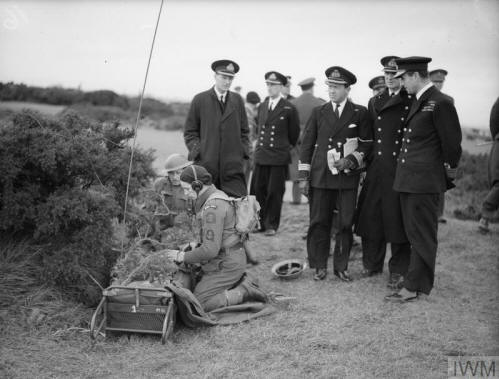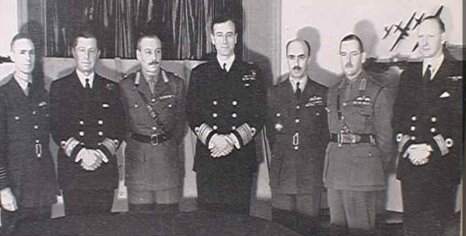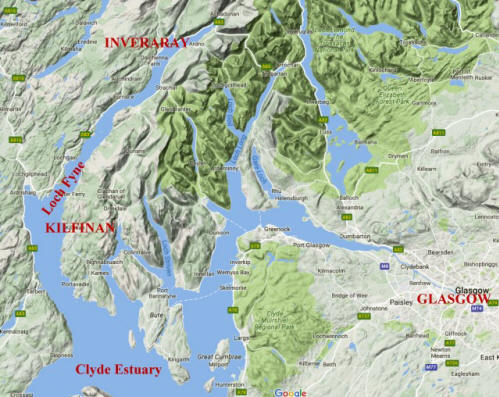|
Mountbatten.
Chief of the Combined
Operations Command, 1941 to 1943
The Early Years
 Mountbatten
was born on 25 June 1900, the younger son of Prince Louis of
Battenberg, who was Admiral of the Fleet and First Sea Lord in 1914.
At the age of 13, Mountbatten entered the Royal Naval College at
Osborne, where he passed out 15th out of 83 cadets. His service
started in the First World War at the tender age of 16. Mountbatten
was born on 25 June 1900, the younger son of Prince Louis of
Battenberg, who was Admiral of the Fleet and First Sea Lord in 1914.
At the age of 13, Mountbatten entered the Royal Naval College at
Osborne, where he passed out 15th out of 83 cadets. His service
started in the First World War at the tender age of 16.
[Photo; HM The King paid a private visit to COHQ on
29th September 1942 to meet officers. He was received by Lord Louis
Mountbatten. © IWM (A 11967)].
He gained
experience of battleships, submarines and destroyers and was an
acknowledged expert in signals. He became a well known and respected
public figure endowed with energy, spirit, dash and intellectual
ability. The Navy concurred with this view as his rise through the
ranks would later illustrate. His was a career overflowing with
challenges and achievements. We concentrate here on his time with
Combined Operations.
Appointment to Combined Operations
In August of 1941,
Mountbatten was appointed captain of HMS Illustrious... a command
he eagerly anticipated while his ship lay in Norfolk, Virginia for repairs,
following action in the Mediterranean in January. During this period of
relative inactivity, he paid a flying visit to Pearl Harbour. He was not
impressed with the poor state of readiness and a general lack of
co-operation between the Navy and Army, including the absence of a joint
HQ. These were interesting observations, in view of what was about to happen to
Mountbatten himself and later to Pearl Harbour!
An Admiralty signal caught
up with him on his return journey to Norfolk, Virginia. It was a personal telegram
from Churchill, recalling him by the fastest possible means, to the UK.
The order was not to be challenged or queried. Despite an assurance from Churchill, that he was required for "something that you will find of the
highest interest," Mountbatten was far from happy to have the command of
his dreams snatched away.
His subsequent
meeting with Churchill at Chequers was far from harmonious but, in a
visionary briefing, Churchill defined the role of Combined Operations
Adviser along the following lines;
-
he was to
succeed Roger Keyes in charge of Combined Operations,
-
he was to
develop a programme of Commando raids along the North Sea and Atlantic
coastlines of enemy held territory. These would increase in intensity
and design to tie up German resources that might otherwise be used on
other fronts,
-
he was to plan
and prepare for the re-invasion of Europe. This was to be the
overriding priority. In this regard Churchill made the point that all
other HQs were on the defensive. Combined Operations had to think
and plan for offensive operations.
Mountbatten's
military achievements and qualities were not well understood outside naval
circles and he was succeeding a man of great renown, 28 years his senior
and of much higher rank. Superficially he was not, therefore, the most
obvious successor to Keyes. However, what Mountbatten had in abundance was
tact and diplomacy - personal qualities that were to help overcome inter
service rivalries and promote a sense of mutual trust,
confidence and common purpose.
 Duties
and Responsibilities Duties
and Responsibilities
On taking up his new
duties on 27 October 1941, a new directive (job description) had been
prepared and approved by the Chiefs of Staff. Unlike Keyes' directive, or
his interpretation of it, there was no mention of the Minister of Defence
(Churchill). His remit included "technical adviser on all aspects
of, and at all stages in, the planning and training for Combined
Operations" specifically;
[Photo; Lord Louis Mountbatten at Dundonald Camp,
Ayrshire on 9 Dec 1942 watching a signal section at work. In the centre
is Cdr Robertson. © IWM (A 13230)].
-
coordinating
inter-service training,
-
running the UK
Combined Operations Training Establishments (Inveraray and others),
-
advising on
tactical and technical research and development,
-
devising the
special craft needed "for all forms of Combined Operations varying
from small raids to a full scale invasion of the Continent."
Mountbatten inherited a
Combined Operations HQ (COHQ) that required substantial change to meet the
new tasks and challenges ahead. He set about major changes to personnel,
organisation and communications. There were no planning staff, no signals
staff, no training staff and no Chief of Staff and only a token
intelligence presence. He immediately set about recruiting the staff he
needed and additional premises to those occupied by COHQ at Richmond Terrace. Such were the dynamics of the changes that, for some weeks, internal
communications broke down under the strain! The enormity of the challenge
would have daunted many lesser men but, within five weeks, Mountbatten had
produced a set of proposals for the Chief's of Staff and he had the
confidence to act upon them before receiving formal approval.
 Within a few months,
the Chiefs of Staff realised they had an adviser, whose position and standing were clear
to all and whose reputation would continue to improve with the passage of time. Above all, the
Chiefs of Staff were prepared to back Mountbatten to the fullest extent. He had,
after all, the full backing of the Prime Minister and everyone knew it; but they
also knew that there was no question of him (Mountbatten) abusing his position. Within a few months,
the Chiefs of Staff realised they had an adviser, whose position and standing were clear
to all and whose reputation would continue to improve with the passage of time. Above all, the
Chiefs of Staff were prepared to back Mountbatten to the fullest extent. He had,
after all, the full backing of the Prime Minister and everyone knew it; but they
also knew that there was no question of him (Mountbatten) abusing his position.
[Photo; COHQ 13/4/42: L to R
-Group Captain A H Willets, Rear Admiral E H Horan, Major General J
C Haydon, Lord Louis Mountbatten, Air Vice Marshall J M Robb,
Brigadier G E Wildman-Lushington (Royal Marines) and Commodore R M
Ellis].
As a consequence, he was elevated to Chief of Combined Operations on
18/03/42. To a large extent, the greatest testimony to Mountbatten's stewardship
of Combined Operations is the historical record he left behind, much of which is
the subject of this website.
D-Day was the
culmination of Mountbatten's plans and preparations for offensive operations
against the German forces. Although he had left for Burma some 8 months prior to
D-Day, Churchill wrote to him following his visit, with others, to the Normandy
beaches on D Day + 6.
"Today we
visited the British and American Armies on the soil of France. We sailed through
vast fleets of ships with landing-craft of many types pouring more men, vehicles
and stores ashore. We saw clearly the manoeuvre in progress of rapid
development. We have shared our secrets in common and helped each other all we
could. We wish to tell you at this moment in your arduous campaign that we
realise how much of this remarkable technique and therefore the success of the
venture has its origin in developments effected by you and your staff of
Combined Operations."
(Signed)
Arnold, Brooke, Churchill, King, Marshall, Smut.
In recognition of
the great contribution to the war effort of Combined Operations under
Mountbatten's stewardship, this signal forms part of the information display at the
Combined Operations Memorial in the grounds of the National
Memorial Arboretum in Staffordshire.
 The Kilfinan Egg
- the personal recollections of a child who met Mountbatten briefly
in 1942. The Kilfinan Egg
- the personal recollections of a child who met Mountbatten briefly
in 1942.
During the war years, Sheena
Simpson lived with her parents, Jean and Adam Campbell, at the Kilfinan Hotel in
the little parish of Kilfinan, near Tighnabruaich on the shores of Loch Fyne,
Scotland. She now lives in Canada with her family but reminisces about a VIP
guest, who arrived at the hotel in February 1942.
[Map courtesy of Google Map Data 2017].
It was early in the month
and her mother had just had a visit from a Major Harrap and another officer
informing her that the hotel was to be commandeered for about a week to 10 days,
while a Combined Operations exercise took place. She was also told that, on the
final days of the exercise, they would be receiving, for breakfast, a VIP guest
with his equerry. Mother almost fainted. She was so sure it was going to be
King George. 'Only royalty have equerries!' she gasped, to which I replied: 'No
mother, I think it will be Lord Louis Mountbatten.' This made sense to me as it
was to be a Combined Operations exercise and Mountbatten was the top man.
There was quite a buzz in
the hotel that week with MPs guarding the doors and lots of saluting and
stamping of feet every time an officer went past. It was like something out of a
British movie. Lord Mountbatten arrived in a Jeep type vehicle and wore regular
naval uniform, whereas, most of the other officers were in battle dress with warm
sheepskin jerkins on. The weather that February was very cold . Other VIPs that
met at the hotel on that final day of the exercise with Mountbatten were General
Alexander, General Festing, Air Marshall Harris and also the War Minister at
that time, Sir James Grigg. The hotel didn't need too much preparation for our
visitors but the dining room was rearranged to accommodate everyone for the
final breakfast. There were two sittings; first the lesser ranking officials and
then approximately 20 top brass. I was very impressed with the concern and
courtesy shown to mother and myself by the big wigs. We were provided with help
for serving from General Festing's servant and he was just super at his job.
The hotel had been issued
with extra rations, so we were able to make bacon and eggs for everyone, much to
Lord Mountbatten's delight. Later on that afternoon, Mountbatten and his equerry
came back on their own, looking for a very quick cup of tea. As the kettle was
going to take too long to boil, Lord Mountbatten decided to have a small ginger
ale instead. This I got from the bar. Mother was getting in a flap having
this handsome, charming, courteous man, in naval uniform, with all the gold
braid of an Admiral, actually in her kitchen. It was all getting too much for
her. Mountbatten's equerry asked how much was owed for the ginger ale. Mother
laughed and coyly said 'Oh nothing , nothing at all.' To me, all of 17
years, this seemed unfair and I piped up politely, 'I think it's thruppence
ha'penny.' This said, Mountbatten's aide produced the exact change.
At this point, they asked if
we had any eggs left which they could buy - there was only one! The egg was produced,
this time no charge, and was carried away by Lord Mountbatten in his leather
gloved hand. All this constitutes a picture, which is clearly etched on my memory
and I often wonder if the Kilfinan Hotel egg made it back whole to the destroyer
anchored out on Loch Fyne. We were all worn out by the
end of the week and everything seemed so quiet. Later that year was the raid on
Dieppe with Mountbatten in charge. I wondered if that week's exercise had all
been part of the training.
Why was the Kilfinan Hotel
used for such a VIP gathering? Maybe because it was out of the way, yet at the
heart of the Combined Operations Training Area and not far from the Loch. Many
VIPs visited Argyll during the period to watch newly developed amphibious
landing training methods.
The
No 1 Combined Training Centre at Inveraray, which specialised in amphibious assault techniques
and the army base at Ardlamont, Loch Fyne, received over a quarter of a million servicemen and
women for training during the early to mid 1940s.
Many of them returned to Argyll over the years to honour the memory of their
comrades who did not return from the field of conflict.
Further Reading
There are around 300 books listed on
our 'Combined Operations Books' page. They, or any
other books you know about, can be purchased on-line from the
Advanced Book Exchange (ABE). Their search banner link, on our 'Books' page, checks the shelves of
thousands of book shops world-wide. Just type in, or copy and paste the
title of your choice, or use the 'keyword' box for book suggestions.
There's no obligation to buy, no registration and no passwords.
Richard Hough;
Mountbatten: hero of our time; London : Weidenfeld & Nicolson, 1980
xiii, 290 p. ISBN 0297778056
Philip Ziegler Mountbatten : the official biography London : Collins,
1985 786 p. ISBN 0002165430
John Terraine The life and times of Lord Mountbatten : an illustrated
biography based on the television history London : Hutchinson, 1968 x, 197
p. ISBN 0090888103
Brian Loring Villa Unauthorized action : Mountbatten and the Dieppe Raid
Toronto ; New York : Oxford University Press, 1989 xiii, 314 p. ISBN 0195406796
Eugene L. Rasor Earl
Mountbatten of Burma, 1900-1979 : historiography and annotated bibliography
Westport, Conn. : Greenwood Press, 1998 xvii, 139 p. ISBN 0313288763
Acknowledgements
The Kilfinan Egg -
the inside story of a visit by Mountbatten to a small hotel in rural Argyll was
written by Catriona McColl for a local newspaper and copied here with her
permission.
|





